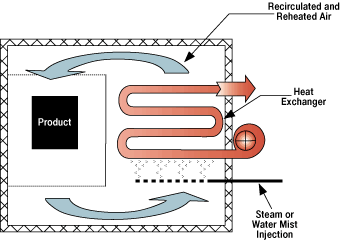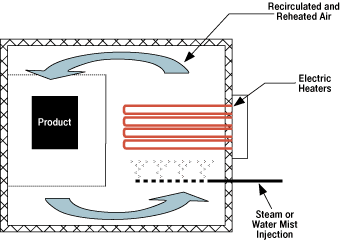White Paper: Using Humidity Control in Heat Processing
By Mike Grande
July 8, 2014
It isn’t as hard as you might think to specify a humidity-controlled oven.
Often, it’s necessary to do more than simply adding heat to a product to achieve the desired result in heat processing applications. Sometimes it’s beneficial to increase and control the relative humidity to reduce the drying effect of convection heating. Some example include: curing certain coatings on glass, drying sealants on aircraft parts, processing lead battery plates, paper processing, drying aluminum printing plates, and curing special gasket material.
When do you need humidity control? It depends on your process.
For instance, certain gasket materials, applied as a caulk-like bead, require an elevated humidity environment to cure into a durable, foam-like state. Perhaps these materials need to be heated to 120°F (49°C) at a 90% relative humidity for optimum cure, for example. Your gasket material or coating supplier can assist in determining the best heating and humidity profile.
Quality assurance testing is another potential application. For example, some electronics manufacturers will simulate worst-case environmental conditions by exposing their products to elevated temperature and relative humidity.
Depending on your process requirements, enhanced humidity oven systems can be designed as batch-type or continuous. If you feel it will benefit your process, there’s no need to be apprehensive about implementing an enhanced relative humidity oven system.
What is Humidity Control?
We must first define relative humidity (RH). Relative humidity is the ratio of moisture (water) in the air at a given temperature to the maximum amount of moisture the air can hold at that temperature. Hot air can hold more moisture than cool air; therefore, as the temperature of air increases, relative humidity decreases. If you want to maintain a constant relative humidity while heating the air, therefore, moisture must be added. And, to increase the relative humidity of air already at an elevated temperature, you must add substantially more moisture.

Figure 1. Because products of combustion from the burner
can disturb the moisture-to-air ratio in humidity controlled
ovens, gas-fired ovens must employ an indirect heating
method in which the burner is fired through a heat exchanger.
When speaking of humidity control, it’s important to understand that the two key variables, temperature and relative humidity, are interrelated, and relative humidity is the dependent variable. You can’t specify a certain relative humidity without also specifying a corresponding temperature.
In a process application, humidity is controlled by adding the desired amount of moisture to the air while maintaining the desired temperature. If a system is designed properly, it really is as simple as that. Depending on the method of humidity enhancement, your system can be configured in several ways.
How is Humidity Increased in an Oven?
Humidity can be added in several ways. One technique utilizes air-atomizing nozzles. Air and water are mixed by the nozzles, injecting a mist into the airstream inside the oven. Separate piping assemblies are used for air and water, each with its own valves, filters and pressure regulator. During system setup, both pressure and flow of the air and water are adjusted to achieve proper nozzle misting. A sensor measures the relative humidity and opens and closes the water solenoid valve as required to maintain the desired relative humidity.
The nozzle technique is simple and inexpensive, but is only suitable for lower temperatures and lower relative humidity. It can easily provide 20 to 30% relative humidity at 120°F, for example. Another disadvantage is that not all of the mist generated by the nozzles immediately evaporates. Some moisture carried in droplet form collects on internal surfaces. To prevent water from dripping or spraying onto the product being processed, precautions must be built into the oven design. A drip pan typically is required to collect unevaporated moisture.
Another approach for enhancing humidity is to inject steam into the oven, often (but not always) into the air recirculation ductwork. A steam generator is required with this technique. The primary advantage of steam humidification is that higher relative humidity can be obtained (up to 100% at certain temperatures). Additionally, steam humidification is a constant dry-bulb process. This means adding humidity has little effect on the oven temperature, because the water is already evaporated before injection into the oven. In contrast, the oven’s own heat is used in the nozzle technique to evaporate the water, so increased oven heat input is required to counteract the cooling effect of evaporation.

Figure 2. Electric resistance heating elements are used
in electrically heated, humidity controlled ovens.
The main drawback of the steam injection approach is greater complexity and capital cost. The steam generator must be purchased and installed as a separate unit along with the oven. Depending on the system design, water softeners also may be required, adding to the cost. As with nozzle humidification, a drip pan typically is required. Higher relative humidity levels may even necessitate locating the oven directly over a drain. Typically, the same types of sensors used in nozzle systems are suitable for steam.
Other methods used by oven manufacturers can best be described as hybrid systems, in which steam is generated by heaters inside the oven. Hybrid systems can often provide a satisfactory cost-performance balance.
Equipment Required
When enhancing relative humidity in any system, a means of sensing the humidity to provide closed-loop control of the steam or atomizing nozzles is necessary. Low cost electronic relative humidity sensors are available for most applications. For example, for temperatures up to 662°F (350°C) a thin film polymer type is suitable. Another common sensor is the wet/dry bulb type. This design has certain advantages, but it’s limited to lower temperatures. More exotic sensors may be required by certain special applications for relative humidity measurement and control. Variable capacitive measurement devices, for example, measure relative humidity at temperatures up to 1,220°F (650°C) or even 1,832°F (1,000°C). Finally, portable instruments are also available, which record the relative humidity data for downloading later, while accompanying the product on the conveyor.
Oven Design. Ovens must incorporate special features for use in enhanced relative humidity applications. Many relative humidity-specific features are costly, but necessary. The system you purchase should be designed with your application in mind.
If the system will be used frequently with high relative humidity levels, a stainless steel interior provides longevity. In a conveyorized process, a stainless steel or acetal (plastic) conveyor belt may be required. To prevent condensation from infiltrating the insulation and eventually saturating it, it is important that the oven interior shell be sealed in most applications. Depending on the temperature and relative humidity, sealing the oven can be accomplished in a number of ways.
Typically, enhanced relative humidity ovens are gas or electric heated. To prevent the disruption of humidity control in gas-fired systems, the products of combustion and moisture generated by the burner must not be allowed to mix with the oven process air. To do this, the burner is fired through a heat exchanger, which is then used to heat the oven recirculating air indirectly.
Contact an experienced oven manufacturer to find out how an enhanced relative humidity oven system can benefit your process. They can offer guidance on a successful solution.